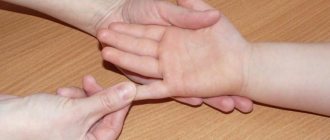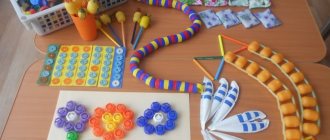The topic of our article is quite relevant since the motor skills of the fingers are closely interconnected with all mental processes, including speech. So A.V. Sukhomlinsky O. Indeed, well-developed fine motor skills have a beneficial effect on the development of all mental aspects. Fine motor skills are motor activities that are aimed at performing small movements with the hands and fingers and toes.
Scientists such as M.M. Koltsova, L.V. Antakova-Fomina, E.I. Isenin believe that the development of children’s speech directly depends on how the subtle movements of the fingers are formed.
To understand exactly how speech and movement are connected, let’s look at the three human brain centers that are responsible for speech. "Broca's area" or motor center produces speech; The speech organs take part in this. The “Wernicke's center” or auditory center is responsible for speech perception, the ability to recognize by ear. And thanks to the third “associative” centers, a person thinks through and analyzes the speech utterance. This is the process of human speech. With insufficient motor activity, the development of speech functions slows down.
Many researchers believe that the activity of the speech center in the central hemisphere of the brain is due to the leading role of the hand in human labor activity. F. Engels notes that the human brain develops under the influence of work and articulate speech.
The close relationship between hand movements and speech was traced in the studies of M.I. Zvonareva and T.P. Chrisman. The study found that when a child performs rhythmic movements with his fingers, the coordinated activity of the frontal and temporal regions of the brain sharply increases. This means that the speech areas of the brain are formed from impulses coming from the fingers.
When performing any movements, all analyzers take part (visual, auditory, tactile, and so on). In this case, the environment and its impact on the child play an important role. Starting from a very early age, it is necessary to pay attention to the development of both gross and fine motor skills. Finger movements occur from a very early age and are improved by the age of six. By this age, he independently performs various manipulations with objects.
T.B. Filicheva notes that imperfections in the development of fine motor skills of children with general speech underdevelopment affect the accuracy of movements, their speed and switchability. Such a child is not able to perform movements smoothly and quickly, or switch from one action to another. Children with general speech underdevelopment find it difficult to differentiate hand movements; they do not recognize some objects by touch (finger gnosis).
A neurological examination of children with general speech underdevelopment reveals the following features: awkward, undifferentiated movements; when overworked, synkenesis (friendly movements) are noted; make mistakes in spatial organization; movements are constrained, not synchronous; tremor (rapid movements of the fingers) is noted; control of one's own actions is impaired.
Thus, children with speech development disorders, later than children with normal speech development, begin to grab and hold objects, sit, walk, and jump on one and two legs. Underdevelopment of fine motor skills causes difficulties in lacing, fastening and unfastening buttons, and holding a spoon and fork in the correct position.
In children with general speech underdevelopment, along with poor coordination of movements, excessive motor activity is observed, which is characterized by sweeping, strong movements. Children with disorders of all aspects of speech have difficulties in the interaction of analyzers, that is, visual-motor and auditory-motor coordination is impaired. For example, when copying, a child with general speech underdevelopment makes many mistakes and distorts the drawing. Or when writing, the child writes letters incorrectly.
When studying auditory-motor coordination of movements, children with ODD make many mistakes. So, the child is given a sample of performing a task by ear - it is necessary to remember the rhythm of tapping in the absence of visual control and then reproduce it. In most cases, children either cope poorly with such a task or do not resort to performing it at all.
The hand movements of children with OHP are not coordinated; it may be difficult for them to perform movements with both hands at once. For example, when assembling a pyramid, a child cannot hold the base with one hand and string rings onto the rod with the other hand.
The so-called “fist, rib, palm” test by N.I. Ozeretskiy is difficult for children to complete. The meaning of the task is this: the child is alternately shown three different positions of his hands on the table, which change sequentially. This is a palm on the plane of the table, a fist, a palm with an edge on the surface. The child needs to complete this task together with the teacher, and then reproduce the same thing independently. As a rule, children with general speech underdevelopment perform this test more slowly than their peers whose speech development is normal. In addition, they get confused in the sequence when performing a task and perform it awkwardly.
Children with ODD find it most difficult to perform tasks in which the position of both hands changes simultaneously. They often make mistakes, make unnecessary movements or shorten them, and can reproduce the same movement without changing position.
Features of motor development are clearly visible in children's visual arts. Children with general speech underdevelopment are poorly oriented on a sheet of paper. They find it difficult to draw a straight line or draw small details, and this, in turn, later affects their writing. This is noticeable when a child writes a letter incorrectly or distorts it; "moves" off the line when writing sentences.
The development of fine motor skills is of great importance when teaching a child with ODD. At the same time, it is important to remember the development of all components that affect the child’s speech development. Thus, it is necessary to train coordination of movements, spatial coordination, motor memory, voluntary motor skills of the fingers; it is necessary to develop dynamic praxis, coordination of hand and eye movements.
Thus, fine motor skills play a big role in the development of a child’s speech. Its development is especially important when teaching a child with general speech underdevelopment, because speech movements are inextricably linked.
Features of the motor sphere in children with ODD
Natalia Pridantseva
Features of the motor sphere in children with ODD
Children with general speech underdevelopment, along with general somatic weakness and delayed development of locomotor functions, are also characterized by some lag in the development of the motor sphere . These children are physically intolerant, get tired quickly, and many have difficulty withstanding a long stay in a group. This fact is confirmed by analysis of anamnestic information. In a significant proportion of children, motor impairment is expressed in the form of poor coordination of complex movements, uncertainty in reproducing precisely dosed movements, and a decrease in the speed and dexterity of their execution. The greatest difficulty is in performing movements following verbal and especially multi-step instructions. Children lag behind normally developing peers in accurately reproducing a motor task in spatio-temporal parameters, disrupt the sequence of action elements, and omit its components.
For example, they find it difficult to perform such movements as rolling the ball from hand to hand, passing it from a short distance, hitting the floor with alternating alternations, jumping on the right and left leg, and rhythmic movements to music. Insufficient self-control when performing a task is also typical.
Children with ODD exhibit peculiarities in the development of fine motor skills of the hands . This manifests itself, first of all, in insufficient coordination of the fingers (for example, when unfastening and fastening buttons, tying and untying shoelaces, etc.).
Facial motor skills are generally calm, but some children experience lethargy or muscle tension and undifferentiated facial postures. Difficulties are caused by tasks involving “incomplete action”
: squint your eyes, stretch out your lips, as if to whistle; close your eyelids slightly.
As for speech motor skills , the following are noted: pronounced changes in muscle strength, accuracy, range of movements, difficulties in switching speech movements, tongue deviation.
Thus, in children with OHP, weakness, inaccuracy in completing tasks, slow switching, incomplete volume, the presence of synkinesis (movements of the lower jaw, raising of fingers, frowning of the eyebrows, raising of the shoulders, inability to hold a given position) were noted.
Thus, in correctional and educational work with children with special needs, special attention should be paid to motor development . Fine motor skills of the fingers and motor skills of the articulatory apparatus are much more effectively developed in parallel with general motor skills . Children with ODD need special exercises to develop general motor skills , to improve coordination of movements and words, to develop a sense of rhythm, and to overcome motor awkwardness .
Causes of general speech underdevelopment (GSD) in children
As a rule, OHP occurs as a result of damage to the nervous system in a child during intrauterine development, immediate childbirth, or the first years of life (before speech skills begin to form). The most common causes of the disorder include:
- infections, toxicosis, bad habits, severe general illnesses of the mother during pregnancy;
- Rhesus conflict;
- fetal hypoxia;
- difficult birth accompanied by injury and/or asphyxia of the baby;
- traumatic brain injuries and neuroinfections in the first years of life;
- social factors: lack of attention from adults, unfavorable family environment, etc.
Characteristics of OHP degrees
Depending on the degree of speech impairment in OHP, speech therapists distinguish 4 levels of speech development in a child, which largely determine the type of correction.
Level 1 of speech development (ONR first degree)
This degree of OHP in children is accompanied by a complete absence of speech, which inevitably affects the development of the baby. Characteristic signs of the disorder are:
- vocabulary consisting of the simplest words, their fragments or onomatopoeias;
- maximum reduction of complex words to 1-2 syllables or their absence in speech;
- active use of facial expressions and gestures to complement communication;
- lack of phrasal speech;
- relatively rich passive vocabulary (the child understands words addressed to him well).
Level 2 of speech development (ONR of the second degree)
A diagnosis of second-degree ODD in children means that the child can communicate, but with difficulty. Speech consists of a small number of commonly used words. Often, the child pronounces them incorrectly, but in the correct context. As a rule, the baby does not use adjectives and does not understand generalizations. During a conversation, short sentences are used without coordinating words. Articulation is significantly impaired.
Level 3 speech development (OHR third degree)
With this degree of OHP, the baby communicates actively and a lot, has a rich vocabulary and constructs phrases well, including complex sentences. As a rule, parents and close relatives understand him well, but for strangers a “translator” is required. The main problem is the pronunciation of sounds that are pronounced incorrectly, are replaced by simpler ones and often merge with each other.
Level 4 of speech development (ONR fourth degree)
With this degree of speech development disorder in children, manifestations of OHP are minimal and are characterized by:
- blurred sound pronunciation;
- periodically replacing sounds with similar ones;
- periodic errors in the use of certain words (usually adjectives);
- errors in the use of suffixes or cases, etc.
At the same time, the speech is more or less understandable, the vocabulary is rich. However, even this form of OHP can cause learning problems in preschool children, which, in turn, causes a decline in school performance.
Structure and symptoms of OHP
In Russian speech therapy , the term general speech underdevelopment (GSD) refers to a speech pathology in children with normal hearing and primary intact intelligence, which is characterized by a violation of the formation of all components of the speech system [Levina, Nikashina, 1968].
The main signs of OHP in preschool age are a late onset of speech, a slow pace, a peculiar course of its development, a limited vocabulary, fairly persistent difficulties in the formation of the grammatical structure of speech , defects in pronunciation and sound analysis. The connection between speech disorders and other aspects of mental development determines a number of specific features. In children with OHP, the formation of sensory and motor functions, optical-spatial concepts is delayed, they are characterized by a low level of development of the basic properties of attention: there is insufficient stability, switchability, and volume; All types of memory are affected: auditory, visual, motor. While semantic and logical skills are relatively preserved, verbal memory and memorization productivity are noticeably reduced compared to normally speaking children. In some cases, low recall activity is combined with limited opportunities for the development of cognitive activity. Having, in general, complete prerequisites for mastering mental operations accessible to their age, children lag behind in the development of visual-figurative thinking, without special training they have difficulty mastering analysis, synthesis, comparison, and rigidity of thinking is noted.
Clinical, psychological and pedagogical studies have shown that this group of children is extremely heterogeneous not only in terms of the severity of the speech defect , but also in its structure and mechanisms of occurrence; defective speech activity negatively affects the formation of the sensory, intellectual and emotional-volitional sphere. In the 50-60s of the 20th century, supporters of the phenomenological approach (R.E. Levina, N.A. Nikashina, L.F. Spirova, etc.) developed a unified pedagogical approach to manifestations of child speech underdevelopment, heterogeneous in their etiology, and resolved the question of the structure of various forms of speech pathology depending on the state of the speech system. This made it possible to present a picture of the child’s abnormal development in a number of parameters reflecting the state of linguistic means and communicative processes. Depending on the severity of the speech defect, three levels of speech development were identified [Levina, Nikashina, 1968].
Level 1 of speech development . The child does not speak commonly used means of communication. To express requests and thoughts, children resort to facial expressions and gestures, individual babbling combinations and onomatopoeia. The passive vocabulary is wider than the active one, however, a speech therapy examination reveals shortcomings of impressive speech (difficulty in orienting in the addressed verbal material, misunderstanding of issues of indirect cases, meanings of prepositions, grammatical forms of words). The limited ability to perceive and reproduce the syllabic structure of a word is clearly expressed. The sound side of speech is characterized by phonetic uncertainty. The pronunciation of sounds is diffuse in nature, which is due to unstable articulation and low capabilities for auditory recognition of phonemes. For a so-called “speechless” child or a child with babbling speech, the task of isolating individual sounds is motivationally and cognitively incomprehensible and impossible.
Level 2 - the beginning of the development of phrasal speech. The active vocabulary consists of a distorted, significantly lagging behind the age norm, but already a constant supply of commonly used words. There are difficulties in understanding and using prepositional constructions, as well as gross agrammatisms. Morphological elements gradually acquire a distinctive meaning. The phonetic side is characterized by the presence of numerous distortions of sounds, substitutions and mixtures [Methods for examining children's speech, 2003]. There is a dissociation between the ability to correctly pronounce sounds in an isolated position and their use in spontaneous speech. Violations in the sound-syllable structure remain: rearrangement of syllables, sounds, replacement and assimilation of syllables, polysyllabic words are reduced. The insufficiency of phonemic perception is manifested in the immaturity of the processes of differentiation of sounds of different contrasts.
Level 3 - the appearance of a common phrase. Speech understanding is developing significantly and is approaching the age norm. Elements of lexico-grammatical and phonetic-phonemic underdevelopment are preserved. There is insufficient understanding of changes in the meanings of words expressed by prefixes and suffixes. There are difficulties in distinguishing morphological elements expressing the meaning of number and gender, understanding logical-grammatical structures expressing cause-and-effect, temporal and spatial relationships. Against the background of relatively developed speech, inaccuracies in the use of many lexical meanings, agrammatisms, simplification of the syllabic structure of words, and undifferentiated pronunciation of sounds (mainly whistling, hissing, affricates and sonorants) are revealed. Children do not know how to use word formation methods and have difficulty mastering sound analysis and synthesis. In free expressions, simple common sentences predominate; complex constructions are almost never used. A practical study of groups of children with general speech underdevelopment revealed the variety of clinical manifestations of this diagnosis. Conventionally, three groups can be distinguished [Zhukova, Mastyukova, Filicheva, 1990].
In children of the first group, signs of general speech underdevelopment without other pronounced disorders of neuropsychic activity are revealed; there are no lesions of the central nervous system. In one third of cases, the anamnesis contains information about toxicosis in the second half of pregnancy, which leads to complications in the prenatal and natal periods, somatic weakness of the child in the first months and years of life. The mental appearance of these children shows certain features of general emotional immaturity and weak regulation of voluntary activity. The dysontogenetic variant of general speech underdevelopment confirms the presence of minor neurological dysfunctions: dysregulation of muscle tone, insufficiency of fine differentiated movements of the fingers, immaturity of kinetic and dynamic praxis.
In children of the second group, general speech underdevelopment is combined with a number of neurological and psychopathological syndromes, such as hypertensive-hydrocephalic syndrome, characterized by increased intracranial pressure, cerebrasthenic syndrome, manifested in the form of increased neuropsychic exhaustion and emotional instability, and movement disorder syndromes. With this complicated variant of general speech underdevelopment of cerebral-organic origin, children experience motor awkwardness and difficulty switching from one movement to another. Automated execution of simple rhythms and other motor tasks becomes impossible. There is a violation of general and oral praxis, and a lack of phonemic perception. Immaturity of the emotional-volitional sphere is combined with low mental performance and emotional lability. The activities of such children may periodically be unproductive.
In children of the third group, persistent, specific speech underdevelopment of a systemic nature is observed, which is clinically designated as motor alalia - the absence or underdevelopment of speech due to organic brain damage in the prenatal or early period of the child's development. A characteristic sign of motor alalia is pronounced underdevelopment of all aspects of speech. A sharp decrease in the ability to express oneself is manifested against the background of relatively intact speech understanding. Speech activity in such children is extremely low; facial expressions and gestures are preferable to them among the forms of communication with others. Phrasal speech suffers most of all. Normally, the acquisition of the native language occurs involuntarily in the process of verbal communication, has an unconscious, emotional nature and plays an important role in the harmonious development of the child. With motor alalia, de-automation of the speech process occurs, underdevelopment of the dynamic stereotype of speech activity, which causes the formation of a pathological type of linguistic behavior, the main defect of which is the immaturity of voluntary speech activity. In addition to a specific speech defect, many children with motor alalia have disorders of non-speech functions (difficulty in the formation of cognitive activity, underdevelopment of gross and fine motor skills, neurological and psychopathological abnormalities, including behavioral negativism, etc.) [Kovshikov, 2001].
Pathogenetic analysis of the structure of the defect is extremely important when selecting children for specialized institutions and their further education. This approach involves clarifying the structure of the primary speech defect and delimiting speech pathology from externally similar various anomalies of cognitive activity and the emotional-volitional sphere (delimiting ONR from mental retardation, mild forms of mental retardation, current neuropsychiatric diseases leading to underdevelopment of speech, peculiar mental development according to type of early childhood autism ) [Mastyukova, 1997].
Need a consultation with a neurologist? Sign up for a consultation by phone or through the feedback form in the “Contacts” section.
Prevention
Diagnosing a child with ODD does not mean that this disorder cannot be eliminated. Timely and correct correction, compliance with all recommendations of speech therapists and doctors often provides a good result, in which the baby’s speech becomes coherent and understandable until it fully complies with the age norm. Associated violations in this case are also corrected.
Prevention of OHP in children is, first of all, following all doctor’s recommendations during pregnancy, childbirth and the first years of the baby’s life, reducing the risk of injury and regular developmental activities, talking with the child, reading books. It is also important to promptly consult a specialist at the first signs of speech impairment.
If you have any doubts about your baby's speech, do not worry ahead of time. Doctors and speech therapists at the SM-Doctor clinic will conduct the necessary tests and diagnostics, and, if necessary, draw up a program of corrective measures.






